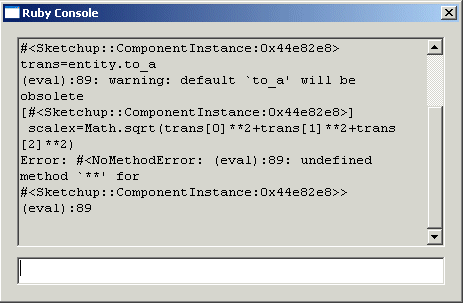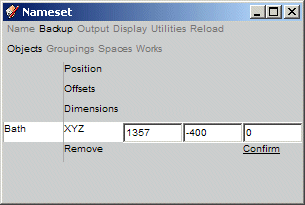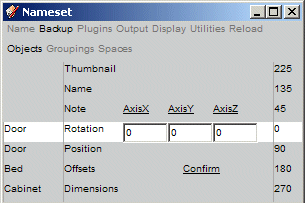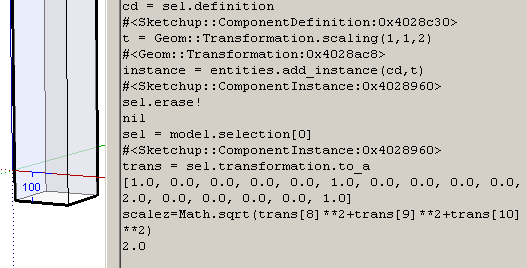Transformation array
-
Please could someone tell me where to find out what these numbers represent in this array.

Thanks
Chris
-
Hi,
This is the 4x4 matrix of the transformation of either a group or a component.Try this snippet (assuming you've got 'trans' from a group/component):
trans=trans.to_a scalex=Math.sqrt(trans[0]**2+trans[1]**2+trans[2]**2) scaley=Math.sqrt(trans[4]**2+trans[5]**2+trans[6]**2) scalez=Math.sqrt(trans[8]**2+trans[9]**2+trans[10]**2) scale=scalex scale=scaley if scaley>scale scale=scalez if scalez>scale puts " <pos>#{trans[12]} #{trans[13]} #{trans[14]}</pos>\n" puts " <scale>#{scale}</scale>\n" puts " <rotation>\n" puts " <matrix>\n" puts " #{trans[0]/scalex} #{trans[4]/scaley} #{trans[8]/scalez} #{trans[1]/scalex} #{trans[5]/scaley} #{trans[9]/scalez} #{trans[2]/scalex} #{trans[6]/scaley} #{trans[10]/scalez}\n" puts " </matrix>\n" puts " </rotation>\n"Hope this helps,
-
Thanks, Didier, but it seems I fell at the second hurdle.

I am afraid I'm a bit out of my depth here. I just want to be able to click on a group or component and have it send its index, xyz and rotation to a javascript array. The index part I can do, so I would be very grateful for any further help with the rest.
My regards
Chris
-
The array represents the Transformation Matrix of the entity. Normally, you don't need to access it in the array form because the Trasformation class has methods for access:
# position; a single point (Point3d) selection.transformation.origin # You need 3 vectors to describe the objects rotation in 3d space selection.transformation.xaxis selection.transformation.yaxis selection.transformation.zaxis -
Chris,
I just realized you probably want the rotation values in a more friendly form for your namesets project. The set of 3 vectors wouldn't be easy to enter, nor understand for that purpose. What does your human interface look like for editing the rotation of an object?
-
@jim said:
What does your human interface look like for editing the rotation of an object?
Thanks, Jim. Yes the idea is to make namesets and Sketchup work together both ways.


(Edit: I should also say that components move on confirm)The input boxes for xyz's and rotation are populated at start up from a csv record (turned into an array) and can be edited and values returned to the array. The call backs in the ruby look like this:
theX = Integer(a[1]).mm theY= Integer(a[2]).mm theZ = Integer(a[3]).mm point = Geom;;Point3d.new theX,theY,theZ txyz = Geom;;Transformation.new point #Courtesy of Jim Foltz theDegrees = Integer(a[4]).degrees theAxis = a[5] rv = Geom;;Vector3d.new(0,0,1) if theAxis == "z" rv = Geom;;Vector3d.new(0,1,0) if theAxis == "y" rv = Geom;;Vector3d.new(1,0,0) if theAxis == "x" tr = Geom;;Transformation.rotation(Geom;;Point3d.new(instance.bounds.center), rv, theDegrees) instance.transform! trWhat would be good would be for the same editing to be done with the move and protractor tools. It seems this is a bit like the relationship between tools and the VCB (now sensibly Measurements).
So, for example, I am now working on animating the distribution of sanitaryware on a building site. In order to set the distribution paths it would be intuitive to click on the destination floor component (rather than a name on a list) and then adjust the route. But then I need the XYZ and rotation to be sent to the js array. The rotation may also be important to turn components to pass through door openings or stack in a material hoist, but maybe not. XYZ's are essential.
Any further help most gratefully received!
My regards
Chris
-
@didier bur said:
Hi,
This is the 4x4 matrix of the transformation of either a group or a component.Try this snippet (assuming you've got 'trans' from a group/component):
trans=trans.to_a > > scalex=Math.sqrt(trans[0]**2+trans[1]**2+trans[2]**2) > scaley=Math.sqrt(trans[4]**2+trans[5]**2+trans[6]**2) > scalez=Math.sqrt(trans[8]**2+trans[9]**2+trans[10]**2) > > scale=scalex > scale=scaley if scaley>scale > scale=scalez if scalez>scale > > puts " <pos>#{trans[12]} #{trans[13]} #{trans[14]}</pos>\n" > puts " <scale>#{scale}</scale>\n" > puts " <rotation>\n" > puts " <matrix>\n" > puts " #{trans[0]/scalex} #{trans[4]/scaley} #{trans[8]/scalez} #{trans[1]/scalex} #{trans[5]/scaley} #{trans[9]/scalez} #{trans[2]/scalex} #{trans[6]/scaley} #{trans[10]/scalez}\n" > puts " </matrix>\n" > puts " </rotation>\n"Hope this helps,
Yes thanks Didier. It just took me a long time to start to get to grips with it. Now here is a situation that has thrown me.

The component sits nicely at 0, 0 on X and Y as trans[12] and trans[13] but at -100 mm not as trans[14] on Z. Is it something to do with the axes settings perhaps?
Thanks
Chris
-
That transformation origin is the components axis. So it looks like perhaps the axis on the component is not set at the base of the component.
Is that the case?
Chris
-
@chris fullmer said:
Is that the case?
Yes! I don't know why it happened, but now I know a little bit more - e.g. to refer to the comp axis when editing. Thanks
Chris
Advertisement







